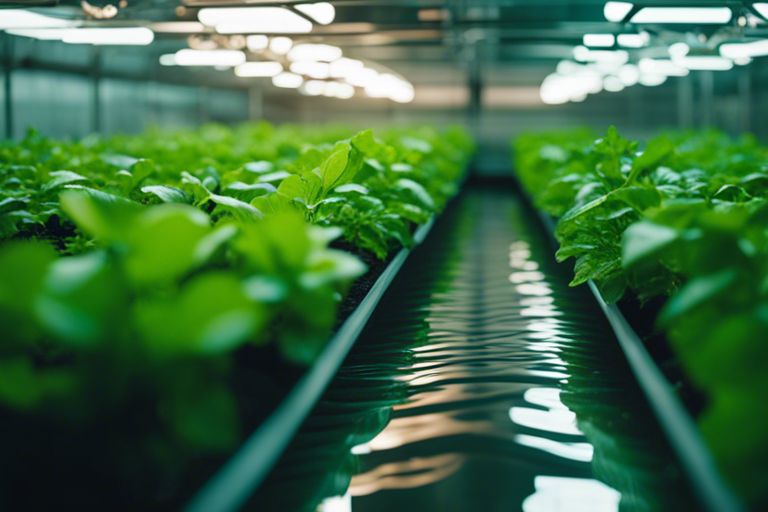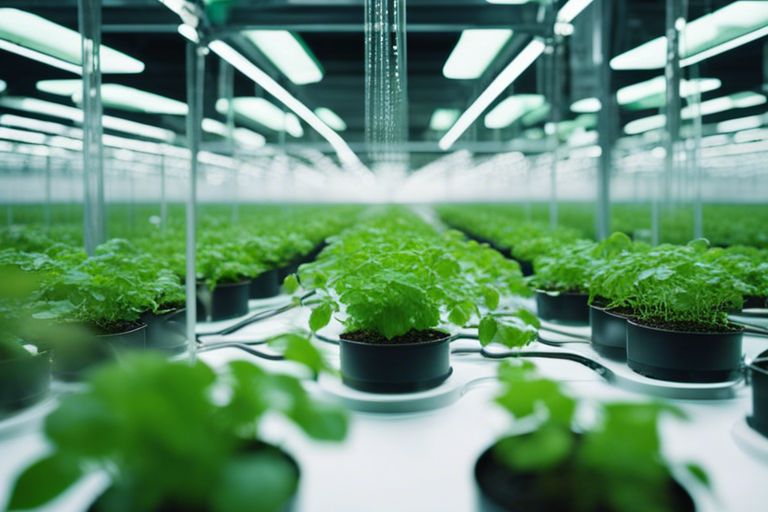With the increasing popularity of indoor gardening, more and more people are turning to hydroponic systems to grow their own produce in a controlled environment. Among the various hydroponic techniques, the Nutrient Film Technique (NFT) stands out for its efficiency and simplicity. NFT hydroponic systems use a continuous flow of nutrient-rich water to feed plants through a shallow channel, allowing roots to be exposed to oxygen while absorbing imperative nutrients. This method not only maximizes space efficiency but also reduces water usage compared to traditional soil gardening. By understanding the science behind NFT hydroponic systems, enthusiasts can unlock the potential for healthy, sustainable, and abundant plant growth.

Key Takeaways:
- Hydroponic Systems Optimization: NFT (Nutrient Film Technique) utilizes a continuous flow of nutrient-rich water to optimize plant growth.
- Plant Nutrient Absorption: NFT hydroponic systems provide direct access to nutrients, allowing plants to absorb them more efficiently than traditional soil methods.
- Water Conservation: NFT systems use minimal water compared to soil-based growing, making them a more sustainable option for agriculture.
- Aeration Benefits: The exposed roots in NFT systems allow for better aeration, preventing root rot and promoting healthier plant growth.
- Space Efficiency: NFT systems are designed for vertical growth, maximizing space utilization and making them suitable for urban farming and indoor gardening.
The NFT Hydroponic System Explained
Any avid hydroponics enthusiast knows the significance of NFT (Nutrient Film Technique) hydroponic systems in achieving optimal plant growth. For beginners looking to explore into hydroponics, understanding why NFT is the best system is crucial. To learn more about why NFT is the best hydroponic system beginners should avoid, check out this article.
Principles of NFT Systems
One of the key principles of NFT systems is the constant flow of a thin film of nutrient solution over the roots of the plants. This system ensures that the roots receive a consistent supply of oxygen and nutrients for optimal growth.
Component Anatomy
To understand the anatomy of an NFT system, one must recognize its key components: the growing tray, nutrient reservoir, pump, tubing, and growing medium. The growing tray houses the plants, while the nutrient reservoir stores the solution. The pump transports the nutrient solution through tubing to the roots, which are supported by a growing medium to maintain stability.
The nutrient reservoir is a crucial component of an NFT system as it holds the nutrient solution and ensures a continuous flow to the roots. The pump plays a vital role in this process by circulating the solution through the tubing, providing the roots with a constant supply of water, oxygen, and nutrients for healthy plant growth.
The Science of Plant Growth in NFT
Nutrient Solution & Plant Nutrition
Little is as crucial to the success of plants in NFT systems as the proper balance of nutrient solution and plant nutrition. Plants rely on various vital nutrients to thrive, including nitrogen, phosphorus, potassium, and micronutrients like iron and calcium. Ensuring that the nutrient solution is well-balanced and delivered in the right concentrations is vital for optimal plant growth.
Oxygenation and Root Health
To promote healthy root systems and overall plant growth in NFT systems, oxygenation is key. Oxygen is vital for root health as it aids in nutrient absorption and prevents root rot. A well-oxygenated root zone ensures that plants can efficiently uptake nutrients and thrive in the hydroponic environment.
Adequate oxygenation not only improves nutrient uptake but also enhances the plant’s resistance to diseases and pests. Insufficient oxygen levels can lead to root suffocation, inhibiting plant growth and productivity. Regular monitoring of oxygen levels in the nutrient solution and root zone is crucial for maintaining optimal plant health and growth in NFT systems.

Advantages and Challenges
Efficiency and Sustainability Factors
Not sure what hydroponic systems are and how they work? Check out this informative article on What Are Hydroponic Systems and How Do They Work?.
With hydroponic systems, the efficiency and sustainability factors are major advantages. By growing plants without soil, hydroponic systems use up to 90% less water compared to traditional soil farming. Additionally, they eliminate the need for pesticides and herbicides, making them environmentally friendly. Hydroponic systems can also be set up in urban areas, reducing the distance that produce needs to travel to reach consumers. Recognizing these factors, it is clear that hydroponic systems offer a more sustainable and efficient method of farming.
Managing Potential Problems
To address potential challenges, it is necessary to be proactive in managing them. It is important to closely monitor the nutrient levels in the water to prevent nutrient deficiencies or toxicities that can harm plant growth. It is also crucial to regularly check the pH levels of the water to ensure they are within the optimal range for plant growth. It is recommended to invest in quality monitoring equipment and to follow a strict maintenance schedule to avoid any issues. Recognizing these challenges and taking proactive steps to address them is key to successful hydroponic system management.
Innovations and Future Prospects
Technological Advancements
After the advent of NFT hydroponic systems, technological advancements have revolutionized the way plants are grown. An emphasis has been placed on automation, precision monitoring, and data-driven decision-making in modern NFT setups. Sensors, digital controllers, and smartphone apps allow for real-time tracking of plant health indicators such as pH levels, nutrient uptake, and environmental conditions. This level of technological integration not only simplifies the cultivation process but also maximizes plant yields and resource efficiency.
The Future of NFT in Agriculture
After the significant impact of NFT hydroponics on agricultural practices, the future holds any even more promising outlook. NFT systems are poised to play a crucial role in addressing global food security challenges by enabling the production of high-quality, nutrient-rich crops in controlled environments. Moreover, the scalability and versatility of NFT systems make them adaptable to various urban farming applications, reducing food miles and promoting sustainable practices.
Technological advancements in NFT systems are set to further enhance their efficiency and effectiveness in agricultural settings. New innovations such as AI algorithms for predictive analytics, advanced LED lighting solutions, and remote monitoring capabilities are on the horizon. These developments will not only optimize crop production but also contribute to stronger sustainability practices by reducing water usage, energy consumption, and overall environmental impact.
Conclusion
With this in mind, it is clear that NFT hydroponic systems offer an efficient and innovative way to grow plants without soil. By utilizing the principles of hydroponics, such as nutrient-rich water and a constant flow system, NFT systems provide a controlled environment for plant growth that yields impressive results. The science behind NFT hydroponic systems demonstrates how this method can optimize plant cultivation, leading to higher yields, faster growth rates, and more sustainable practices. As technology continues to improve, NFT systems will likely play a key role in the future of agriculture by providing a more efficient and environmentally friendly way to grow food.
FAQ
Q: What is an NFT hydroponic system?
A: An NFT (Nutrient Film Technique) hydroponic system is a method of growing plants without soil, where a shallow stream of nutrient-rich water flows over the plant roots, providing them with crucial nutrients.
Q: How does an NFT hydroponic system work?
A: In an NFT system, a thin film of nutrient solution continuously flows over the plant roots, delivering oxygen, water, and crucial nutrients directly to the plants. The roots are exposed to the air, promoting increased oxygen uptake and plant growth.
Q: What are the advantages of using an NFT hydroponic system?
A: NFT hydroponic systems offer several benefits, including efficient use of water and nutrients, faster plant growth, higher yields, and the ability to grow plants in a controlled environment without the use of soil.
Q: What types of plants are suitable for NFT hydroponic systems?
A: Leafy greens, herbs, and some vine crops such as tomatoes and cucumbers thrive in NFT hydroponic systems. These plants have shallow root systems that are well-suited to the continuous flow of nutrient solution in NFT channels.
Q: How can I set up an NFT hydroponic system?
A: To set up an NFT hydroponic system, you will need a reservoir for the nutrient solution, a submersible pump, tubing, NFT channels, growing trays, a pH testing kit, and suitable plants. Follow detailed instructions to assemble the system, maintain proper nutrient levels, and monitor plant health regularly.
